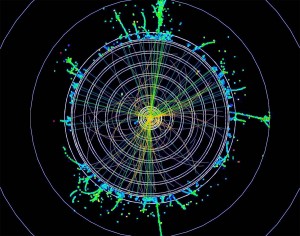Over the past decades, colliders have defined the energy frontier in particle physics. Both electron-positron, proton-(anti)proton as well as electron-proton colliders have played complementary roles in fully mapping out the constituents and forces in the Standard Model (SM). We are now at a point where all predicted SM constituents have been found at colliders. Currently only one collider, the Large Hadron Collider (LHC) is running and will run for a while. The last remaining, predicted field/particle in the SM was found at the LHC in 2012 and with increased luminosity and raising the energy to 14 teraelectronvolts (TeV), the LHC will be the field’s only tool to study the Higgs boson. Especially raising the energy will also enable extending the reach for searching for new physics beyond the SM (BSM).
Trying to explain the SM and its features and parameters leads us to expect new physics and therefore new particles. There are theoretical expectations that such particles are at the TeV-level energy scale, but in principle they could be at any scale above one TeV and even that depends on their interaction strength. In an ideal world the only way to directly produce such particles/fields in our labs is in colliders. Assuming that we need to go beyond the LHC, we would like a collider or colliders that can reach from a few hundred GeV to very high energies, ultimately if one is allowed to dream the Planck scale of 1019 gigaelectronvolts (GeV).
The above reasoning has led to many studies of future colliders at rather different stages of completion or maturity. It is also the driving scientific force behind a worldwide accelerator R&D programme trying to achieve higher accelerating gradients, especially for linear colliders and to achieve higher magnetic fields, for circular colliders. This programme driven by the high-energy physics (HEP) community which needs to build ever higher energy colliders at affordable cost, has led to technologies that enabled other fields of science in obtaining their goals (the European XFEL at DESY, Germany and LCLS II at SLAC, US). These fields often industrialise those technologies before HEP can do it and in that way contribute to possible future machines for HEP. In that way all participating fields of science benefit and contribute.
The studies of future HEP colliders mentioned above are very important aspects of HEP. Over the last two decades several of these studies have been undertaken and some are just being started now. They all aim at proposing a future collider and requiring the development of new technologies to be able to reach the energies aimed at. Typically these technologies do not exist at the start of the study, but are anticipated to be within reach, given sufficient research, development and funding. These studies are also on extremely different time scales of possible realisation of concepts. Currently there are four studies worldwide: ILC, CLIC, FCC and a muon collider. The International Linear Collider (ILC), an electron-positron collider at 500 Gev and possibly upgraded to 1 TeV is the most mature with a Technical Design Report (TDR) and the most established superconducting RF technology. A candidate site has also been identified in Japan to possibly locate the machine. CLIC (Compact Linear Collider) is an eletron-positron collider concept based on two beam acceleration aiming to reach about 3TeV and with a completed Conceptual Design Report (CDR), aiming for a TDR around 2019. A multi-TeV muon collider is under discussion and an active R&D programme of how to cool muons, an essential ingredient, is in progress. Recently the study of a Future Circular Collider (FCC) aiming at about 100TeV centre-of-mass energy for proton-proton collisions has started. It is being pursued both in Europe and in China and will require the development of new superconducting high field magnets (of about 16-20 teslas). The FCC study at least in Europe aims for a CDR around 2018. From a HEP perspective, one can argue about which one of these should be pursued and each of us in HEP has their preference. However there is a strategic aspect associated with this conundrum that cannot be ignored and that is the time scale involved in realising any of these machines. In the most optimistic scenario, the LHC will have a high luminosity run and will run until sometime in the 2030’s. The only option mentioned above that has any chance of some overlap with LHC and/or be accumulating data around that time is the ILC. Even that assumes that the ILC will be realised in Japan on a technically limited schedule without financial or political delays.
So it seems that if HEP wants to continue energy frontier physics with complementary to the LHC, precision exploration of the Higgs and explore BSM physics at weak scales above about 200 GeV, unexplored by the LHC, then the ILC is the natural next energy frontier machine for HEP. Any other option will take at least another decade beyond 2030 before it could be realised. That would result in an extended period of time without a running energy frontier machine in HEP.



Recent Comments